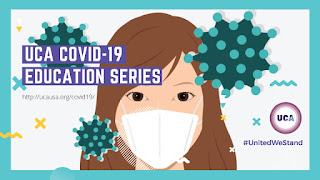52: How to practice social distancing?
Q: How should we practice social distancing?
💁Tracy: In areas with a high prevalence of cases, keeping social distance means avoiding going to risky areas and stay close to other people.
According to current scientific research, proper social distance is more than 1.5 meters, preferably 2 meters. This should effectively prevent the risk brought by a spread of droplets from person to person. This refers to the distance when both people are standing still face-to-face or in line.
Certain situations may make the needed social distancing even further, such as when people talk loudly without masks, cough or sneeze, with AC or wind blowing. Please use common sense to decide what's the best way to maintain a safe distance and reduce your risk of exposure.
Q: What should I do when I meet someone sneezing or coughing?
💁Tracy: When someone sneezes or coughs in front of you, you should change your route to avoid the area where there may be droplets. Stay more than 3 meters from the area.
In windy conditions, if you are on the downwind side of someone who is sneezing or coughing, you should dodge and move upwind quickly.
When talking with sneezing or coughing people, keep a distance of more than 3 meters and stay to the side. In case of wind in the open air, you should stand on the windward side.
💁Tracy’s Tips:
References

💁Tracy: In areas with a high prevalence of cases, keeping social distance means avoiding going to risky areas and stay close to other people.
According to current scientific research, proper social distance is more than 1.5 meters, preferably 2 meters. This should effectively prevent the risk brought by a spread of droplets from person to person. This refers to the distance when both people are standing still face-to-face or in line.
Certain situations may make the needed social distancing even further, such as when people talk loudly without masks, cough or sneeze, with AC or wind blowing. Please use common sense to decide what's the best way to maintain a safe distance and reduce your risk of exposure.
- When running, as the amount of exhaled air and droplets increases greatly, the runner behind would better keep a distance of more than 10 meters from the runner in front. On windy days, the runners should enlarge this distance. If two runners run side by side, the safe distance is more than 1.5 meters. Don't wear a N95 mask when doing sports!
- When biking, the distance between bicycles should preferably be more than 20 meters due to the speed of movement.
- When taking an escalator, you should stand to the right or left more than 3 meters behind a person in front of you.
Q: What should I do when I meet someone sneezing or coughing?
💁Tracy: When someone sneezes or coughs in front of you, you should change your route to avoid the area where there may be droplets. Stay more than 3 meters from the area.
In windy conditions, if you are on the downwind side of someone who is sneezing or coughing, you should dodge and move upwind quickly.
When talking with sneezing or coughing people, keep a distance of more than 3 meters and stay to the side. In case of wind in the open air, you should stand on the windward side.
💁Tracy’s Tips:
- Children under 2 years old, or those who may have difficulty breathing, or maybe affected by wearing N95 masks which will reduce airflow, should consider carefully the risk of wearing masks if they increase the risk of choking or reducing oxygen intake.
- If you have to go to or pass through crowded high-risk areas, minimize your chance and time of interacting with others. Take all precautions and hygiene practice if you can (see our article on attending social gatherings during the COVID pandemics).
References
[1] WHO: Basic protective measures against the new Coronavirus, Maintain social distancing.
[2] WHO: Coronavirus disease 2019 (COVID-19): situation report, 72
[2] WHO: Coronavirus disease 2019 (COVID-19): situation report, 72
[3] BGR Tech: Coronavirus spreads through the air outside with shocking ease, study says.
[4] The Lancet Infectious Diseases: Scientific and ethical basis for social-distancing interventions against COVID-19.
[5] CDC: How to Protect Yourself & Others. https://www.cdc.gov/coronavirus/2019-ncov/prevent-getting-sick/prevention.html
Writing: Zheng Lyu; Proofreading: Helen Shih, Jie Chen; Artwork:






